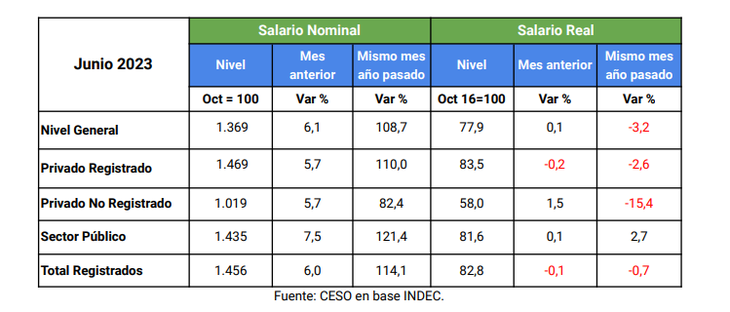While the inflation it was accelerating month by month, the wages of the main items of the economy tried to follow this course to avoid losing the race against prices. A report by CESO (Centro de Estudios Económicos y Sociales Scalabrini Ortiz) tried to show how the parity of the main branches of activity in the first 7 months of the year.
In this context of inflationary acceleration There has been a generalization of “short parities” in quarterly reviews, with very different interannual variations between the different branches. Seven of the ten unions surveyed have achieved real year-on-year improvements in July 2023.
A few weeks from primary elections, it was possible to observe how the wages of formal workers evolved in most cases below inflation. Thus, the imminent need for rebuild income in a context where purchasing power was eroding more and more. For the month of July, several increases were activated that in some cases served as a “recovery” from the abrupt falls in previous months and in others, contributed to a year-on-year variation higher than that of the inflation.
When considering the real basic salary index (ISBR-CESO) by branch of activity, we can to realize that 7 of the 10 surveyed agreements achieved better salary conditions in July 2023 compared to the same month last year. However, almost two months before the general elections, the current political scenario continues to add uncertainty to salary expectations for the remainder of the year.
Wages: which sectors managed to beat inflation
According to the consultant, the following sectors were the ones that made the best agreements:
- Hotel and Gastronomy (+30.9% yoy)
- Food workers (9.3% yoy)
- Construction Workers (7.5% yoy)
- Transport Workers (7.0% yoy)
- Metallurgical (+5.5% yoy)
- Health workers (+0.9% yoy)
- Banking (+0.3% yoy)
salaries.PNG
Salaries: what are the salaries that lost the most
The union that lost the most in real basic salary in July 2023 compared to July 2022 was that of teachers.
Observing the Guaranteed National Minimum Teacher Salary (SMNDG), Teachers had a year-on-year loss of 5.8%. It should be noted that the last national parity established that no teacher may receive less than 145,000 pesos from June and 165,000 from July. This difference between the 145,000 and the starting salary of each jurisdiction is the product of a supplement granted under the National Teacher Salary Compensation Program. They are followed by Truck Drivers (-3.4% yoy) and Commercial Employees (-0.5% yoy).
Salaries: what is the average remuneration according to RIPTE
The Average Taxable Remuneration of Stable Workers (RIPTE) It is the average amount received by workers who have been declared continuously during the last 13 months and who are under a dependency relationship. It is built based on the Affidavits that employers prepare every month and then present to the AFIP.
The RIPTE is $302,563 for June 2023. This implied a monthly increase of 8.1%, 2.1 pp. above headline inflation for June. In year-on-year terms (yoy), the nominal increase was 101.4%, which implies a real fall of 0.7% yoy for the same period.
minimum salary
The variation of the Minimum, Vital and Mobile Wage in the first two months of 2023 was well below the variation of the CPI (-0.4% in January and -3.1% in February). The Ministry of Labor set the increases at 15.6% from April, 6% in May and 5% in June. As of April, the SMVM reached $80,342. For the month of June, the value of the SMVM was $87,987; in interannual terms (yoy), the nominal increase was 70.5%, which implies a real fall of 10.4% yoy for the same period. The Government recently confirmed an increase of 34% (20% in July, 8% in August and 6% in September). In this way, starting in July, it will be $105,500, $112,500 in August and $118,000 in September.
INDEC wage index
In June 2023, the general level of wages increased by 6.1%, just 0.1 pp above 6% inflation and reached a variation of 108.7% yoy Until that month, it implies an annual decrease in real terms of 3.2% yoy
Capturevv.PNG

Registered employment (SIPA)
In the month of May 2023, 10,236 million people with registered salaried employment (including the private sector, the public sector and work in private homes) and 2.924 million people with independent work (monotributistas and self-employed). The set of people with salaried employment registered presented a variation without seasonality of +0.2% in May 2023. This represented some 23,700 more workers.
At the sectoral level, the sectors with the highest registered employment growth in May 2023 were Hotels and restaurants with a positive variation of 0.9% and Agriculture (+0.5%). The following sectors are Construction (+0.4%) and the Mining (+0.4%). The sector that decreased in registered employment is made up of the Fishing (-0.2%). The sectors of Financial Intermediation, Electricity, Water and Gas, and Social Services and Healthhad no growth in registered private employment in the month of May.
Source: Ambito




